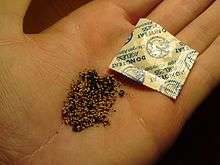Oxygen scavenger


Oxygen scavengers or oxygen absorbers are added to enclosed packaging to help remove or decrease the level of oxygen in the package. They are used to help maintain product safety and extend shelf life.[1] There are many types of oxygen absorbers available to cover a wide array of applications.[2][3]
The components of an oxygen absorber vary according to intended use, the water activity of the product being preserved, and other factors. Often the oxygen absorber or scavenger is enclosed in a porous sachet or packet but it can also be part of packaging films and structures.[4] Others are part of a polymer structure.[5]
Mechanism
The first patent for an oxygen scavenger used an alkaline solution of pyrogallic acid in an air-tight vessel.[6][7]
Modern scavenger sachets use a mixture of iron powder and sodium chloride.[7] Often activated carbon is also included as it adsorbs some other gases and many organic molecules, further preserving products and removing odors.
When an oxygen absorber is removed from its protective packaging, the moisture in the surrounding atmosphere begins to permeate into the iron particles inside of the absorber sachet. Moisture activates the iron, and it oxidizes to form iron oxide. Typically, there must be at least 65% relative humidity in the surrounding atmosphere before the rusting process can begin. To assist in the process of oxidation, sodium chloride is added to the mixture, acting as a catalyst or activator, causing the iron powder to be able to oxidize even with relative low humidity. As oxygen is consumed to form iron oxide the level of oxygen in the surrounding atmosphere is reduced. Absorber technology of this type may reduce the oxygen level in the surrounding atmosphere to below 0.01%.[2][3] Complete oxidation of 1 g of iron can remove 300 cm3 of oxygen in standard conditions. Though other technologies can remove more, iron is the most useful as it does not cause odor like sulfur compounds or passivate like aluminium compounds. Many other alternatives are not food safe.[7] The moisture requirement of iron-based scavengers makes them ineffective in moisture sensitive applications.
The performance of oxygen scavengers is affected by ambient temperature and relative humidity.[8] Newer packaging technologies may use oxygen scavenging polymers to prevent accidental ingestion of oxygen scavengers.[7]
Non-Ferrous Oxygen Scavengers
While most standard oxygen scavengers contain ferrous carbonate and a metal halide catalyst, there are several non-ferrous variants, such as ascorbate, sodium hydrogen carbonate, citrus and others available.[9]
Typical reasons to use a non-ferrous variant would include the packaging of products intended for international shipping where metal detection would pose a problem; a desire to reduce the odor associated with ferrous carbonate; or dietary products where contact with iron should be avoided.[10]
Ascorbic acid is often used to scavenge oxygen for generation of anaerobic environments for microbiology.[11][12]
Benefits of oxygen scavengers
- Helps retain fresh-roasted flavor of coffee and nuts
- Prevents oxidation of spice oleoresins present in spices themselves and in seasoned foods
- Prevents oxidation of vitamins A, C and E
- Extends life of pharmaceuticals
- Inhibits mold in natural cheeses and other fermented dairy products
- Delays non-enzymatic browning of fruits and some vegetables
- Inhibits oxidation and condensation of red pigment of most berries and sauces
- Oxygen deprivation contributes to a pest-free environment in museums
Oxygen scavenging technology can quickly reduce oxygen levels in sealed containers to below 0.01%.[13]
Typical uses
|
|
Sachets
Plastic sachets offer greater protection than paper as they are not prone to disintegrating in products with high fat contents.
See also
References
- ↑ Miltz, J.; Perry, M. (2005). "Evaluation of the performance of iron-based oxygen scavengers, with comments on their optimal applications". Packaging Technology and Science. 18: 21–27. doi:10.1002/pts.671.
- 1 2 Tewari, G.; Jayas, D. S.; Jeremiah, L. E.; Holley, R. A. (2002). "Absorption kinetics of oxygen scavengers". International Journal of Food Science and Technology. 37 (2): 209–217. doi:10.1046/j.1365-2621.2002.00558.x.
- 1 2 MacDonald, Jameyson. "Oxygen Absorbers Facts" (PDF). Retrieved August 2013. Check date values in:
|access-date=(help) - ↑ Ferrari, M C; S. Carranzaa, R.T. Bonnecazea, K.K. Tunga, B.D. Freemana, D.R. Paula,∗ (2009). "Modeling of oxygen scavenging for improved barrier behavior: Blend films" (PDF). J Membrane Science. 329: 183–192. doi:10.1016/j.memsci.2008.12.030. Retrieved 20 Sep 2013. Cite uses deprecated parameter
|coauthors=(help) - ↑ 5660761 A US US 5660761 A, Katsumoto, Kiyoshi, "Oxygen scavenging layer consisting of oxidizable compound, second, separate layer consisting of oxidation catalyst", published 26 Aug 1997
- ↑ US 96871, Virgil W. Blanchard, "Improvement in preserving fruits, meats and other substances."
- 1 2 3 4 Yam, K. L., ed. (2009). Encyclopedia of Packaging Technology. John Wiley & Sons. pp. 842–850. ISBN 9780470087046.
- ↑ Braga, L. R.; Sarantópoulos, C. I. G. L.; Peres, L.; Braga, J. W. B. (2010). "Evaluation of absorption kinetics of oxygen scavenger sachets using response surface methodology". Packaging Technology and Science. 23 (6): 351–361. doi:10.1002/pts.905.
- ↑ Kerry, Joseph; Butler, Paul (May 23, 2008). Smart Packaging Technologies for Fast Moving Consumer Goods. Wiley & Sons. p. 1.
- ↑ Brody, Aaron L.; Strupinsky, E. P.; Kline, Lauri R. (Jun 8, 2001). Active Packaging for Food Applications. CRC Press. p. 20.
- ↑ Dave, Rajiv I.; Shah, Nagendra P (1996-10-19). "Effectiveness of ascorbic acid as an oxygen scavenger in improving viability of probiotic bacteria in yoghurts made with commercial starter cultures". International Dairy Journal. 7: 435–443. doi:10.1016/S0958-6946(97)00026-5.
- ↑ Niki, E (1991). "Action of ascorbic acid as a scavenger of active and stable oxygen radicals". The American Journal of Clinical Nutrition. 54 (6 Suppl): 1119S–1124S. PMID 1962557.
- ↑ Clariant. "Product Sheet for OXY-GUARD™ Oxygen scavengers" (pdf). Retrieved 2013-11-14.